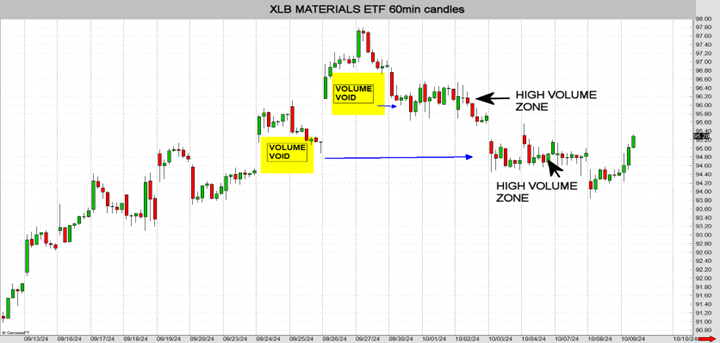How to Handle Low-Volume Pockets
As a futures broker, I had many clients who used automated or algorithmic systems for trading management. These trading systems are mainly developed to capture vertical moves. When a buy/sell signal is triggered it frequently has a domino effect that causes prices to move rapidly. The most common bullish breakouts occur when the top of a channel (flag) or pennant (triangle) is violated. A bearish trend often begins when the bottom of a flag or pennant is breached. The type of candlestick at the onset of a breakout can be revealing as well. Candles with full bodies and small wicks are an indication of dominance. Thus, a full-bodied candle passing through a trendline is often the catalyst for an above average vertical move. When a market breaks into a trend it is often fast and furious leaving behind gaps or low-volume pockets known as volume voids.
Vertical vs. Horizontal Phases
As an analyst and educator, I try to keep it simple by classifying market movements into two phases. The vertical phase may be described as a breakout, imbalance, trend, run, rally, dive or dip. A vertical phase is either bullish or bearish. During the horizontal stage a market is consolidating, congesting, balancing, coiling, resting or developing value over time. Rest phases follow run phases, which lead to rest phases and the process repeats.
Leaving Low-Volume Zones Behind
When markets break free from consolidation phases they often do so quickly with above average volume and ranges. Run phases can be violent as the market moves from balance to imbalance. During such runs markets move with time; they do not stop to rest or develop value. While doing so low-volume zones or gaps are often left in the wake.
Filling Volume Voids
Low-volume zones or gaps are frequently revisited. It is as if the market must spend time filling in voids with volume before resuming the trend. The ETF XLB chart below illustrates this common phenomenon. The volume voids that were left behind eventually became high-volume zones. I think of this pattern as a puzzle with pieces missing. A new trend may not commence unless the missing piece (volume) accumulates in the open area or volume void.

Apply Neutral Strategies
Once this pattern is recognized neutral option strategies should be applied. A mean reversion or neutral trading strategies work well in this environment. Markets often oscillate around a mean or moving average while the gap is being filled.
Short straddles or strangles should perform well during a consolidation phase. Iron condors and butterflies are designed to profit from very little price movement as well. Credit spreads may also apply as premium decays while the market finds balance within the low-volume area. Covered calls may be used when gaps are left behind during a rapid rise in price.
Rather than applying your favorite strategy on any pattern, it is better to identify whether a market is in a trend or consolidation phase, then apply the best tactic.
John Seguin, Market Taker Mentoring
